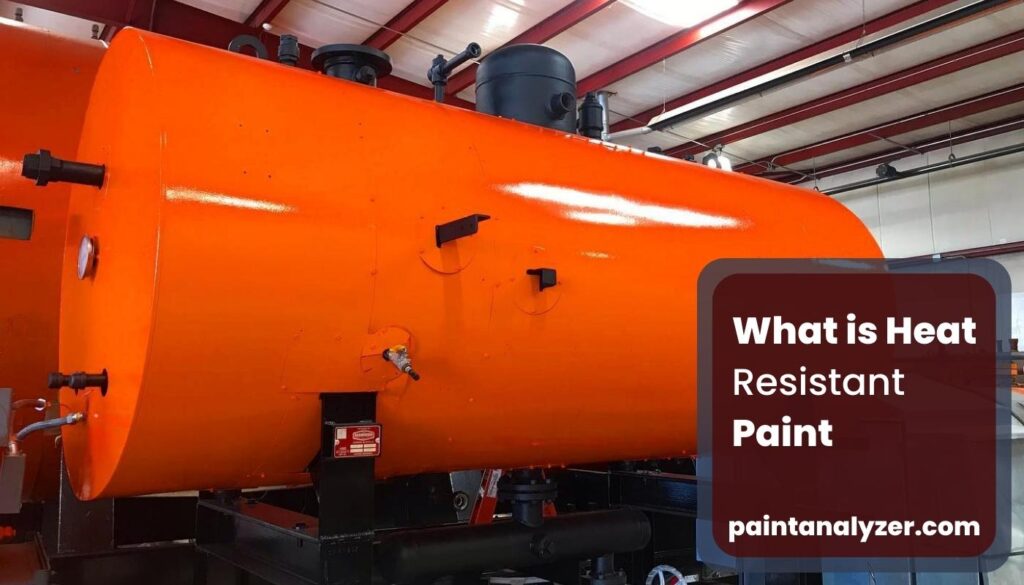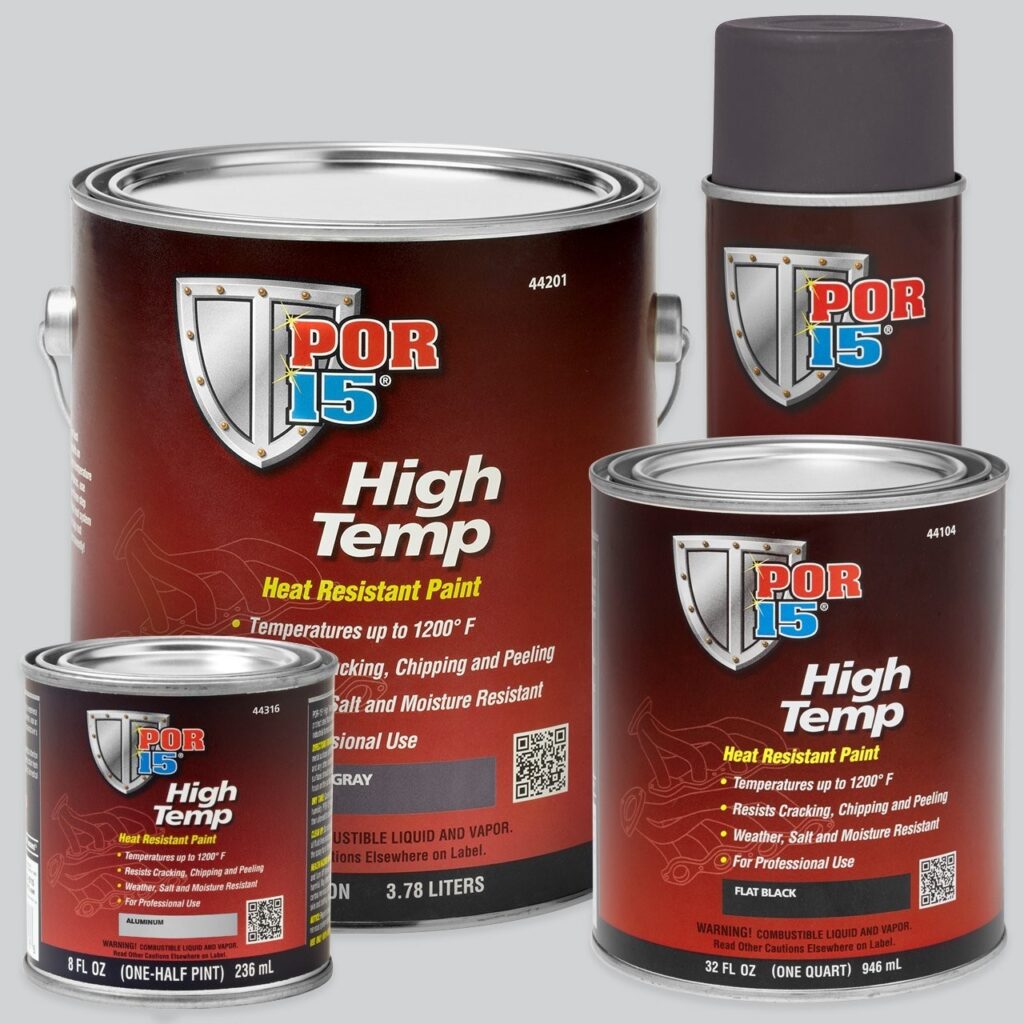Heat-resistant paint is a type of paint that is designed to withstand high temperatures. It is often used on metal surfaces that are exposed to heat, such as fireplaces, stoves, and radiators. The paint acts as a barrier between the surface and the heat, protecting the material from damage.
Heat-resistant paint can also be used on metal surfaces that are exposed to heat, such as car engines. If you are planning on painting any surfaces that will be exposed to high temperatures, then heat-resistant paint is a must.

What is the purpose of heat-resistant paint?
When it comes to protecting surfaces from high temperatures, heat-resistant paint is a must. This type of paint is often used on industrial equipment, boilers, and pipes. It can also be used on fireplaces and BBQ grills. Heat-resistant paint is available in a variety of colors, so it can be used to match the decor of any space.
Heat-resistant is specially formulated to withstand high temperatures, typically without discoloration or loss of adhesion. This type of paint is commonly used on metal surfaces that are subject to heat, such as engine blocks, exhaust pipes, and grills. Heat-resistant paint can also be used on other surfaces that might get hot from time to time, such as stovetops, light fixtures, and fireplaces.
This type of paint is usually made from a type of resin that is designed to withstand high temperatures. The key ingredient in heat-resistant paint is usually silicone resin. This resin is mixed with a variety of other ingredients, such as pigments and fillers, to create the final heat-resistant paint.
This gives the paint its resistance to heat, as well as making it waterproof and durable. The ingredients used in heat-resistant paint can vary depending on the manufacturer.
Some other types of heat-resistant paints may also contain ceramic microspheres, which help to reflect heat away from the surface. So, if you need tough and durable paint that can withstand high temperatures, then look for good quality heat-resistant paint.
Can You Apply New Paint Over Heat-Resistant Paint?
Yes, you can paint over heat-resistant paint. However, it is important to note that not all paints are created equal. Some paints may be more resistant to heat than others. Additionally, the type of paint you use will also affect how well it holds up to heat. Here are a few things to keep in mind when painting over heat-resistant paint:
Paint Over Clean Surface
Make sure the surface is clean and free of any grease or dirt. Heat-resistant paint can be difficult to remove, so it’s important to start with a clean surface. If the surface isn’t clean, the new paint may not adhere properly and could eventually start to peel.
Sand Before Painting
If the surface is not completely smooth, you may want to sand it before painting. This will help the new paint to adhere better. – Use a primer designed for use on heat-resistant surfaces. This will help the new paint to last longer.
Good quality paint
Choose a paint that is designed for use on high-heat surfaces. This means that the new paint should be able to withstand high temperatures without blistering or peeling. These paints are usually oil-based and have a higher temperature rating. You can ask your local paint store for recommendations on which paint to use.
Where You Can Use Heat-Resistant Paint?
While most paints can only withstand temperatures of up to 200 degrees Fahrenheit, there are some specially designed heat-resistant paints that can withstand much higher temperatures. These paints are typically used on surfaces that are regularly exposed to high temperatures.
Heat Resistant Paint for Boilers
In order to protect your boiler from the high temperatures, it will experience during operation, you need to use heat-resistant paint. There are many different types of heat-resistant paint on the market, so it is important to choose one that is specifically designed for boilers. One type of heat-resistant paint that is often used on boilers is called intumescent paint.
This type of paint expands when it gets hot, creating a thick barrier between the heat and the metal surface. Intumescent paint can withstand temperatures up to 1,200 degrees Fahrenheit. Another type of heat-resistant paint that can be used on boilers is called ceramic-based paint.
This type of paint contains tiny ceramic particles that help reflect heat away from the surface. Ceramic-based paints can withstand temperatures up to 2,000 degrees Fahrenheit.
Heat Resistant Paint for Oven
When applying heat-resistant paint to your oven, there are a few things to keep in mind. You’ll need to decide what type of paint you want to use. There are two main types of heat-resistant paints: silicone-based and ceramic-based.
Silicone-based paints are more flexible and can withstand higher temperatures. However, they’re also more expensive. Ceramic-based paints are less expensive.
Once you’ve decided on the type of paint, you’ll need to choose a color. Heat-resistant paints come in a variety of colors, so you should be able to find one that matches your kitchen decor.
Heat-resistant paint can be dangerous if not used properly, so it’s important to read the directions before getting started.
Heat Resistant Paint for Metal
Whether it’s from the sun or from industrial equipment, the heat can be intense. That’s why it’s important to have heat-resistant paint for metal surfaces.
This type of paint can withstand high temperatures and protect the metal underneath. It’s perfect for items like grills, fire pits, and even vehicles that are exposed to extreme heat on a regular basis. There are a few things to keep in mind when choosing a heat-resistant paint for metal.
You need to make sure that the product is designed specifically for metal surfaces. There are many paints out there that claim to be heat resistant, but they may not stand up to the high temperatures associated with metal surfaces.
Next is color, Black is a popular choice because it doesn’t absorb as much heat as lighter colors do. However, any dark color will work well. Also, you’ll need to decide whether you want oil-based or water-based paint.
Water-based paints are typically easier to apply and clean up, but oil-based paints offer better protection against high temperatures.
How Do You Apply Heat Resistant Paint?
You might need heat-resistant paint if you’re planning to use a surface for activities that generate high heat. This type of paint can be applied to many materials, including metal, glass, and ceramic. It’s important to follow the instructions on the paint can and take proper safety precautions when using heat-resistant paint. Here’s a brief overview of how to apply it.
Step 1: Sand the Surface
Start by sanding the surface you’ll be painting. This will help the paint to adhere better.
Step 2: Use Primer
Apply a primer specifically designed for use with heat-resistant paint.
Step 3: Start Painting
Once the primer is dry, you can begin painting. Paint in a well-ventilated area, as heat-resistant paints often have strong fumes. Be sure to apply the paint in thin, even coats to ensure the best results.
Step 4: Let the Paint Dry
When you’re finished painting, allow the paint to dry completely before exposing the surface to high temperatures. It’s important to follow the manufacturer’s instructions carefully.
What’s the best way to apply heat-resistant paint?
There are a few things to consider when applying heat-resistant paint: the type of surface you’re painting, the temperature of the surface, and the type of paint. For most surfaces, a high-temperature enamel or epoxy is best. These paints can withstand temperatures up to 1200 degrees Fahrenheit.
If you’re painting a metal surface that will be exposed to direct flame, you’ll need ceramic-based paint that can withstand temperatures up to 3000 degrees Fahrenheit. The surface you’re painting also needs to be clean and dry before you start painting. Any grease or moisture will prevent the paint from adhering properly.
Sand the surface lightly to create a rough texture for the paint to grip onto. Once you’ve chosen the right paint and prepared the surface, it’s time to apply it. Use a sprayer or roller designed for use with high-temperature paints for best results.
These applicators will help ensure an even coat of paint. Start by applying a thin layer of paint, working in small sections at a time. Overlap each stroke slightly to avoid leaving any bare spots.
Once the first layer is dry, apply another thin layer in the same manner until you’ve achieved desired coverage. Allow each coat of paint to dry completely before applying the next. Let the final layer of paint dry completely before exposing it to heat.
What Types of Paint is Heat Resistant?
There are many different types of paint that are heat resistant and can be used for a variety of applications. Some of the most common types of heat-resistant paint are epoxy paint, silicone paint, and urethane paint. Each type of paint has its own unique properties that make it ideal for specific uses.
Epoxy paint is one of the most durable types of heat-resistant paint and is often used in high-temperature environments. It is able to withstand temperatures up to 120 degrees Celsius (248 degrees Fahrenheit) and can resist both chemical and abrasion damage.
Silicone paint is another type of heat-resistant paint that can withstand high temperatures. It is often used in applications where there is a need for high heat.
Urethane heat-resistant paint is a type of paint that is designed to withstand high temperatures. It is often used on metal surfaces that are exposed to heat, such as ovens, stoves, and fireplaces. Urethane paint is also resistant to chipping and fading, making it an ideal choice for areas that see a lot of wear and tear.

Credit: por15.com
Conclusion
Heat Resistant Paint is a specially formulated coating that can be added to any paint, latex, or waterborne coating. The layer will not only increase the paint’s resistance against heat up to 1,000 degrees Fahrenheit, but it also provides the same resistance to UV rays.
The paint, when applied onto a surface, can help reduce the surface temperature of a surface by up to 10°C, thus improving comfort. With Heat Resistant Paint, homeowners and businesses can rest assured that their paint job will last for years to come.

